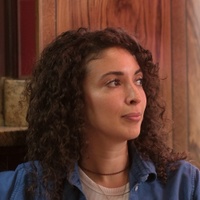On letting your community support you
Prelude
Born and raised in Seoul Korea, Jun Yang lived in Dublin Ireland, Belgium, and France before settling in San Francisco. Jun is a self-taught artist, his paintings, murals, and textile sculptures draw inspiration from his childhood traumas, healing journey, experiences of grief, and the Queer immigrant experience. For the past several years, Jun has focused on creation representing POC Queer bodies through painting, sewing fabric sculptures, and sculpting figures out of clay to reflect on marks and evidence of survival, growth, and nourishment. Jun combines his art with activism, reflecting his personal journey as a Queer immigrant and advocating for LGBTQ+ and immigrant rights by celebrating inclusivity and solidarity he has found in San Francisco while exposing ongoing struggles.
Conversation
On letting your community support you
Artist Jun Yang discusses who deserves to see art, the act of doing nothing, and making art for your community.
As told to Daniel Sanchez-Torres, 2641 words.
Tags: Painting, Art, Adversity, Inspiration, Beginnings, Mental health.
What path led you to where you are today? What has been the most surprising thing you’ve realized along your creative path?
Okay, I’m a very honest person, so I’m going to tell you when my mom died of cancer. I’m still very sad thinking about it. I came out of it a completely different person because it just destroyed me. It was devastating. And then my dad also passed away three years after her death. That was just, like, insane. Like, I thought “I’m going to die. There’s no more reason to really work hard, or there’s no place to go back to.” I felt that I [didn’t] have any people that I can lean on or rely on. I’m sure a lot of people also felt that when they lost some people they really, really love. But parents are very important for a lot of Asian kids or Asian families, because we are very connected.
That was the moment I realized, oh, wow, we can die anytime. Life can be hell and then also heaven. So I started to paint because it was more for survival reasons, I had nothing to do. First of all, I couldn’t walk. For some reason, I had a lot of pain in my body. Now I know why, because our mental health is deeply related to our physical health. It was very hard for me, I was applying for disability because I wasn’t able to walk for over a year, I was carrying a cane and using a scooter. That was the moment I decided to be an artist and that I wanted to change everything.
When did your mom die?
She died nine-and-a-half years ago.
Were you living in the United States?
I was here, yeah.
That’s intense.
It is intense. I came [to the United States] by myself, I did not want to go back to Korea. I was visiting my ex-boyfriend and I did not like San Francisco because it was so expensive. I lived downtown. There were so many homeless people, but I just didn’t want to go back to Korea. I applied for an asylum visa and they granted it. And then my parents passed away and it was devastating because I didn’t have much memories [of them.] I didn’t spend a lot of time with them when they were healthy and able to create memories together so that was very hard.
What were your early paintings like?
I was painting a lot of abstract. I used a lot of water, I love the sensation of [touching] the water. I painted with my hands because there’s something about getting dirty or messy and dancing and crying and expressing myself very ugly and very dirty. I just felt like I had to let it out. It [was] like a cleansing effect. I just felt like “it’s cleaning my body.” I told you, I had a lot of pain in my body, so it was a lot of cleansing and it was therapeutic. Also I had a kind of ritual every morning. Getting up and taking a shower. I was thinking, “I’m cleansing my body and my soul,” and then [go] to the studio and paint. I was thinking, “I’m cleaning a lot of my guilt from grief.” I was blaming [myself] for what happened to my parents, that I wasn’t a good son. I was away, I lived in Europe before coming [to San Francisco] so I was always trying to run away from my family and my country. Seeing and touching your scars and facing what happened to you and why you were running away from certain people and situations—that’s the only way to heal, I think.

Jun Yang, Here & Now, 2024, acrylic on canvas, 70 x 60 inches
How does the piece start for you?
My current work, a lot of it is coming from imagination. Self portraits and friends I knew before, and people I met online. Or like people visiting my studio and people I meet at shows or at the park. There are so many beautiful parks and beaches in San Francisco.
You said “my current work,” did the way that you started making work change throughout your career?
It changed a lot during the pandemic. I used to paint animals and flowers because they were very healing. Just looking at them and smelling them. During the pandemic, I was living in the Tenderloin in a small studio apartment. It was heartbreaking to see all the homeless people sitting [out] on a rainy day. I cried when I came home because I was just like this is fucking [inhumane], some people have so much money just across the street. In Van Ness, in Pacific Heights, living in castles and these people are dying in the street and nobody gave a fuck.
I was using flowers as my therapy. We were sheltering in place, I wasn’t able to go out and sometimes people delivered flowers and I was looking at them and started painting and arranging them and also combining actual flowers with my paintings with me in it. And then after George Floyd passed away, I started to read more about this country and I was paying more attention to politics and also a lot of social issues. I started to paint portraits.
I was grieving relating to what some people of color and minority artists were going through. And I kind of saw myself too, being an immigrant and coming here alone and going through grief and all these harsh experiences. So my main reason why I started to paint some of my friends or people I think are beautiful or people others should know about is because I was lonely. I thought this might help other people feel less lonely because when I put the art out there, they will see themselves. Or maybe this is also my solidarity to my community. After we got the vaccines, I was able to go out and I don’t know—I wanted to be more positive about a lot of things, my body, my sexuality, and myself and my friends. I started to appreciate so much more. I wanted to feel more free. So, I started to paint really large figures. I’ve never done that before. I never took any figure drawing classes or anything, I just started.
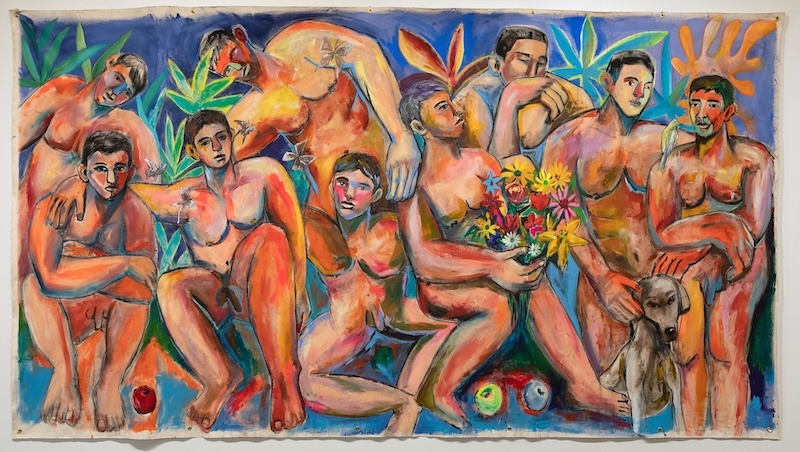
Jun Yang, Boundless Connections, 2024, acrylic, oil pastels, pastels, and spray paint on canvas, 142 x 87 inches.
What’s something you wish someone told you when you started to make art?
I didn’t know anything about administrative work, like paying sales tax quarterly. I didn’t sell much [at the time] but I didn’t know how to charge local government tax or any of that shit. And filing income tax was very confusing—still confusing! And even stuff like how to install hanging wire to the back [of my work], packing and shipping, sales tax, building a website, opening an online store, sending a newsletter. All this stuff I had to figure it out, but I also got lots of help from my friends. So yeah, love from my community and fellow artists, they shared a lot of tips and advice.
What do you do when you’re creatively stuck?
I like to go to the park. Connecting with nature is very important because it helps me. I love doing nothing, actually but I can’t because I can’t afford doing nothing. I’m going back to Korea to do a lot of dental work. I have better insurance there, but I’m planning on doing nothing. Just eating and hanging out with friends and reconnecting with my Korean family. When I’m stuck I also go to museums and galleries. Seeing is very important, because art is not just about techniques. Basically, I’m showing my world. People ask me “What is that? What does it mean?” Sometimes it’s just how I feel. I’m not a writer, I’m not an actor, I’m an artist. I paint how I feel, how I see the world.
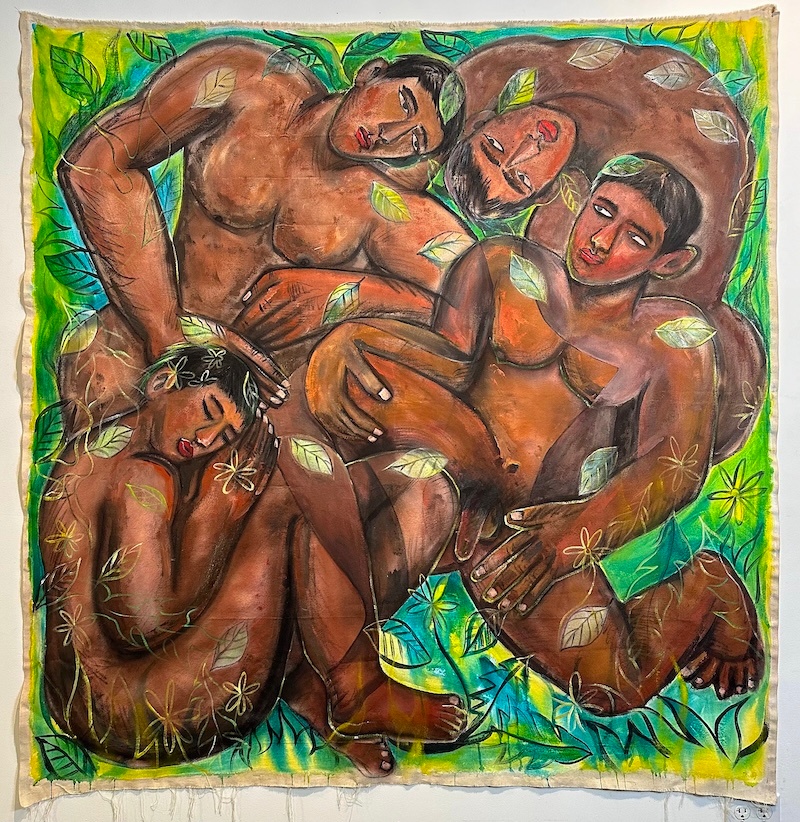
Jun Yang, Wild Connections, 2024, acrylic on canvas, 63 x 63 inches.
I’ve followed you on Instagram for a while and something that I’ve noticed is that you’re very vocal about how often your posts have been taken down or instances where your art has been censored by the platform. What has been the role of social media in your creative practice and how your work reaches an audience?
It’s very stressful. Actually, I do a lot of meditation because I try not to rely on social media too much. But, for example, I’m going to Berlin and I’m meeting with Kyte and Chow. They both live in Berlin, and we connected through Instagram in like 2021. I’m also meeting other artists that live in Hamburg and other parts of Germany and [I met them] all through Instagram. So, Instagram is really important.
I don’t know what they are doing, but I’m devastated every time my content gets blocked from being seen by others. That’s already stressful enough, but sometimes other artists are really negative about me posting or sharing about what’s happening to me. That is also psychologically very annoying. They tell me they can still see my posts, so I can’t be blocked. I’ve found it really discouraging. Obviously, I can tell my content is being censored, and it’s unfair. I try not to be too stressed out because they cannot stop me from creating and painting, all I can do is just be hopeful and positive and keep sharing. They might do something again, but I don’t know.
What have these challenges of censorship meant about how you think about how you show your work and how you get people to see your work?
I want people to sign up for my newsletter and go to my website. It’s hard. Instagram has millions of people on it. Galleries and curators message me via DMs. They don’t need to email anymore or even check out my website. Actually, my New York show, I applied through Instagram. We were selecting work via DMs, everything we did was [Instagram] DMs. So I was like, wow—the power of Instagram. I underestimate it. But I don’t know why they think my work is explicit.
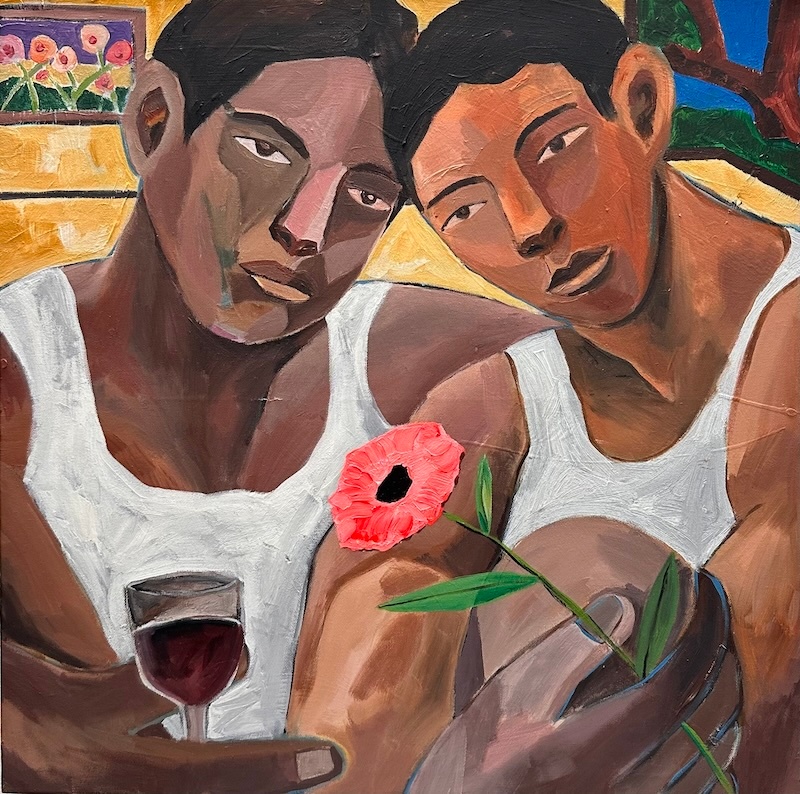
Jun Yang, Quiet Hours, 2024, acrylic on canvas, 25 x 25 inches.
My first interaction with your work was the collaboration you did with Brontez Purnell at Steamworks Baths. Brontez played a set of songs while your work was projected on the walls around him. Your work was also playing on a loop on one of the channels on all of the TVs in the bathhouse. How did that collaboration come about? What makes you want to collaborate with another artist?
Steamworks reached out to me like two years ago. Zose, the manager, is a friend and we met at Steamworks. I love Steamworks, I love bathhouses. I’m Korean, I grew up with bathhouses. I love bathhouses because we weren’t able to go to any other place to explore sex and relationships. Gay people, we’re always going to parks or bathhouses. There’s nothing wrong with that. I like the old fashion way to meet guys. I don’t want to waste my time online so I like going there and being naked.
While I was there the manager saw my Grindr and my Instagram was linked to my profile and that’s how the manager saw my work. He messaged me and offered me a show at Steamworks. But two years ago, I didn’t want people to know I was going to Steamworks. I didn’t know if it would help [my work] or if it was necessary. This is kind of my private life and what I did for fun. I just told him I wasn’t sure. Then, this year, he reached out again, we had lunch, and this was during the time all the Instagram [censorship] was happening, so I just thought “why not?” I love this place and a lot of people also go there and this is our community. Some people go there and they don’t speak English or they have different reasons why they don’t want to show who they are, but they go there for fun and to connect.
Zose was the one who suggested Brontez and sent me Brontez’s album on Spotify and I loved it. I started to follow him [on Instagram] and saw his videos and other work and then I finally met Brontez at Steamworks. My work was displayed, it was kind of immersive on projectors and tv screens. And Brontez was singing. This was the first time I saw older guys, some of them had a cane, and they told me they [have been] coming to Steamworks for years and this is the first time they ever saw something like this and they really loved it. People were talking to each other after the show. So I thought, wow this was really great. People can also enjoy the art, everybody deserves to see art, it doesn’t have to be in a gallery or museum.
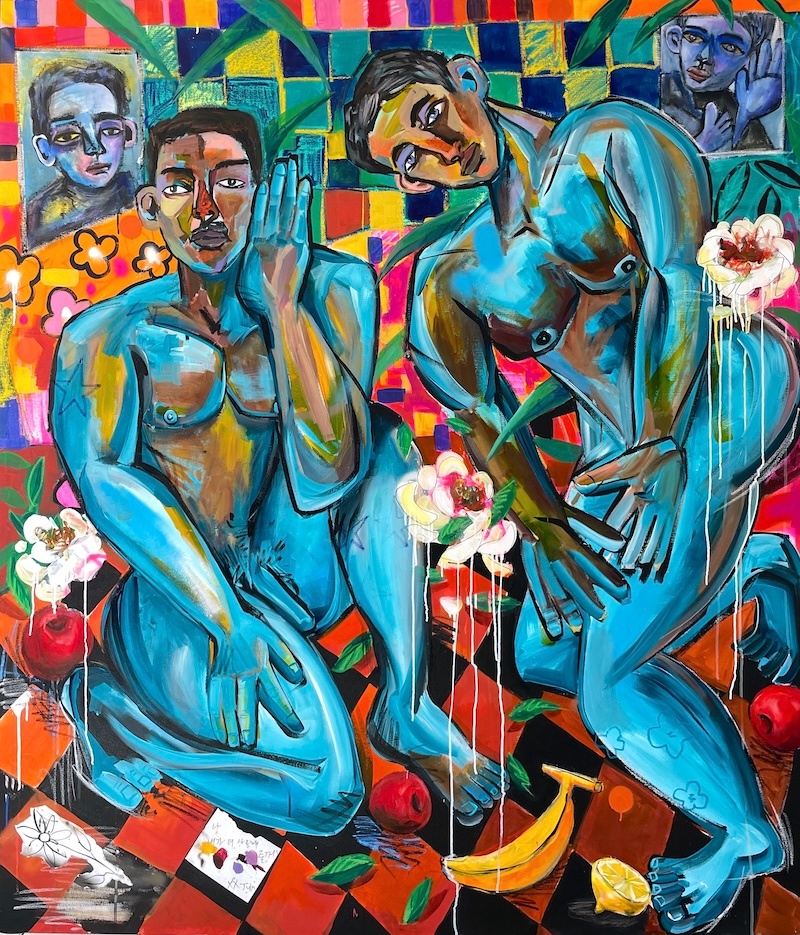
Jun Yang, Old Me New Me, 2022, acrylic, spray paint, paper collage on canvas, 72 x 62 inches.
After I saw your work at Steamworks, I realized that I’ve seen your work all over the city and the Bay Area. I also noticed your work on the walls of galleries and studios and I realized you also had a show at Strut, the health and wellness center in the Castro. I’ve also met artists in the city and when we share Instagram information they get so excited when they realize I follow you and have such great things to say about you. What made you commit to this community and this city?
I’ve had so many bad experiences with my insurance. But then I started going to Strut and they don’t ask me a lot of questions and it’s sliding scale donation based. I pay $20 or $25 and they prescribe me DoxyPEP and do all my [STD] testing for free. When I first moved here, I didn’t know anything about viruses like syphilis or gonorrhea. Going there, they explained everything to me and the doctors and nurses were so friendly. When I saw their open call, I was like, I’ve been going there since I moved to San Francisco and I was just fresh off the boat. I didn’t know anything. I went there because someone suggested I go there to get tested and they [took care of me]. It’s very important to me. I got lots of support and love and they also became my friends and my collectors. They encourage me. They tell me, “You can do it.” You know what I mean? They really believed in me in a way I didn’t believe in myself. I thought I was just going to be a flea market artist, but they really told me I could do it. So yeah, I want to help other artists who are like me who don’t think they can do shows. I think that’s what really pushed me to have shows in community spaces and public spaces, because I want to share it, and the more people see it, I don’t know maybe that will help them feel like they can do it, too.
Jun Yang recommends:
Morning sun
My friends, my chosen family
Good decaffeinated coffee
Redwood forests
Asian food
- Name
- Jun Yang
- Vocation
- artist
Some Things
Pagination
